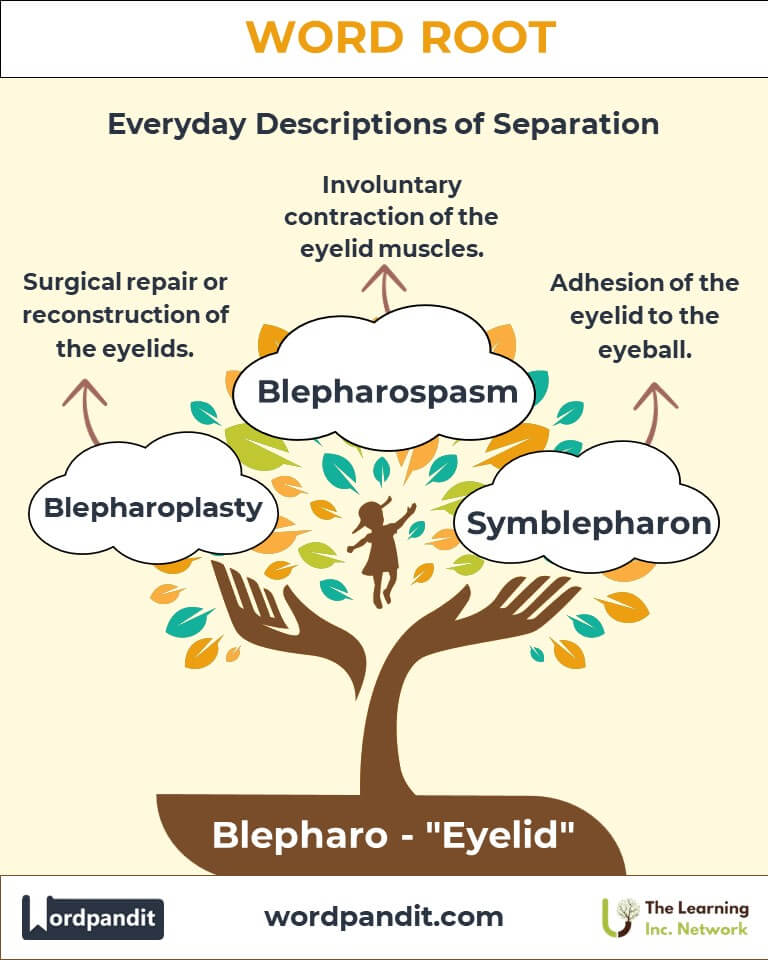Blepharo: The Gateway to Vision in Language and Medicine
Byline:
Discover the origins and significance of "Blepharo," a word root derived from Greek, meaning "eyelid." From medical terminologies like blepharitis to intricate surgical techniques like blepharoplasty, this root unveils fascinating insights into vision, beauty, and health.

Table of Contents
- Introduction: The Essence of Blepharo
- Etymology and Historical Journey
- Mnemonic: Unlocking the Power of Blepharo
- Common Blepharo-Related Terms
- Blepharo Through Time
- Blepharo in Specialized Fields
- Illustrative Story: Blepharo in Action
- Cultural Significance of the Blepharo Root
- The Blepharo Family Tree
- FAQs about the Blepharo Root
- Test Your Knowledge: Blepharo Mastery Quiz
- Conclusion: The Living Legacy of Blepharo
Introduction: The Essence of Blepharo
The word root "Blepharo" (pronounced BLEF-uh-roh) comes from the Greek word blepharon, meaning "eyelid." It forms the foundation of many terms in medicine and biology, particularly those dealing with the structure, function, and conditions of the eyelids. Whether discussing blepharitis (inflammation of the eyelid) or blepharoplasty (eyelid surgery), the root showcases its pivotal role in the fields of health and aesthetics.
Etymology and Historical Journey
The root "Blepharo" traces back to ancient Greek, where blepharon referred to the eyelid. In classical texts, the term was often used metaphorically, symbolizing protection or the gateway to sight. Over time, its adoption into Latin and subsequent incorporation into English medical terminology cemented its relevance in ophthalmology and plastic surgery.
Mnemonic: Unlocking the Power of Blepharo
Imagine a butterfly (blepharoptera) delicately fluttering its wings, much like the motion of eyelids blinking. This imagery ties the root to its meaning.
Mnemonic Device:
"Blepharo helps you blink and behold the beauty of the world."
Common Blepharo-Related Terms
- Blepharitis (BLEF-uh-RY-tis): Inflammation of the eyelids.
Example: "The patient was diagnosed with blepharitis after complaining of redness and irritation around the eyes." - Blepharoplasty (BLEF-uh-roh-plas-tee): Surgical repair or reconstruction of the eyelids.
Example: "She underwent blepharoplasty to correct drooping eyelids affecting her vision." - Symblepharon (SIM-BLEF-uh-ron): Adhesion of the eyelid to the eyeball.
Example: "Symblepharon can result from severe ocular trauma or burns." - Blepharospasm (BLEF-uh-roh-spaz-um): Involuntary contraction of the eyelid muscles.
Example: "The patient experienced blepharospasm, causing frequent blinking." - Ankyloblepharon (ANG-kuh-loh-BLEF-uh-ron): A condition where the eyelids are partially or completely fused.
Example: "Ankyloblepharon is often corrected surgically in newborns."
Blepharo Through Time
- Ancient Uses: In Greek art and literature, "blepharo" was a poetic symbol for sight and subtle expressions.
- Modern Medical Innovations: The rise of blepharoplasty in the 20th century highlighted the importance of the root in cosmetic and reconstructive medicine.
Blepharo in Specialized Fields
- Ophthalmology: Essential for diagnosing and treating eyelid conditions like blepharitis.
- Cosmetic Surgery: Blepharoplasty enhances aesthetics and corrects functional issues.
- Veterinary Medicine: Addresses conditions like blepharospasm in animals.
Illustrative Story: Blepharo in Action
Dr. Elena, an ophthalmologist, encountered a patient suffering from severe blepharospasm that hindered his daily activities. Employing advanced botulinum toxin injections, she alleviated his symptoms. The patient marveled at his restored ability to blink and see clearly, underscoring the vital role of "Blepharo" in enhancing quality of life.
Cultural Significance of the Blepharo Root
The eyelids have often been romanticized in poetry and art as windows to the soul. Terms derived from "Blepharo" highlight the delicate balance between aesthetics and function, reflecting humanity's fascination with the eyes' expressive power.
The Blepharo Family Tree
- Oculo- (Eye): Example: Ocular – Pertaining to the eye.
- Opt- (Vision): Example: Optometrist – A professional who examines eyes for visual defects.
- Palpebro- (Eyelid): Example: Palpebral – Relating to the eyelids.
FAQs About the Blepharo Root
Q: What does "Blepharo" mean?
A: "Blepharo" originates from the Greek word blepharon, meaning "eyelid." It is primarily used in medical terminology to describe conditions, treatments, and anatomical aspects related to the eyelids.
Q: Is blepharoplasty only for cosmetic purposes?
A: No, blepharoplasty is not limited to cosmetic enhancement. While it is often performed to reduce sagging eyelids for aesthetic reasons, it is also a functional surgery to correct ptosis (drooping eyelids) that can impair vision or cause eye strain.
Q: What are common causes of blepharitis?
A: Blepharitis is usually caused by bacterial infections, clogged oil glands at the base of the eyelashes (meibomian gland dysfunction), or skin conditions such as rosacea or seborrheic dermatitis. Proper hygiene and targeted treatments are often required to manage it.
Q: Can blepharospasm occur without any other eye conditions?
A: Yes, blepharospasm can occur as a standalone condition, often classified as a type of dystonia (a movement disorder). It may also be triggered by stress, fatigue, or certain neurological conditions.
Q: What is symblepharon, and how is it treated?
A: Symblepharon is the adhesion of the eyelid to the eyeball, often caused by trauma, burns, or severe conjunctivitis. Treatment typically involves surgical separation of the adhered tissues and may include grafting to prevent recurrence.
Q: How does blepharitis affect vision?
A: While blepharitis does not directly impair vision, chronic inflammation can lead to discomfort, blurry vision due to tear film instability, or secondary complications like styes and dry eye syndrome.
Q: What is ankyloblepharon, and when does it occur?
A: Ankyloblepharon is a rare condition where the eyelids are partially or completely fused. It can occur congenitally or as a result of trauma or severe scarring. Surgical intervention is often required to separate the eyelids.
Q: Are blepharoplasty results permanent?
A: While blepharoplasty provides long-lasting results, it does not stop the natural aging process. Over time, the skin may lose elasticity, and additional procedures might be required to maintain the desired outcome.
Q: Can animals also suffer from blepharo-related conditions?
A: Yes, animals, particularly dogs and horses, can experience conditions like blepharitis, blepharospasm, and even congenital ankyloblepharon. Veterinarians often address these issues with treatments similar to those used for humans.
Q: What role do eyelids play in vision?
A: Eyelids are essential for protecting the eyes from debris, excessive light, and injury. They also help distribute tears across the surface of the eye, maintaining hydration and preventing dryness, which is vital for clear vision.
Test Your Knowledge: Blepharo Mastery Quiz
1. What does "Blepharo" refer to?
2. What is blepharoplasty?
3. Which condition involves eyelid inflammation?
4. What does "Symblepharon" describe?
5. Which root also means "eyelid"?
Conclusion: The Living Legacy of Blepharo
The root "Blepharo" encapsulates the intricate interplay between health, beauty, and function, highlighting the vital role of eyelids in protecting vision and enhancing expression. From medical breakthroughs to cultural symbolism, this root continues to shape our understanding of sight and aesthetics, making "Blepharo" an enduring cornerstone of language and innovation.













